|
It has been almost two and one-half years since
I first reviewed the .480
Ruger Alaskan revolver. The Alaskan series from Ruger
has proven to be very popular with those who want to carry a
compact but powerful handgun as protection from big hairy things
that bite and claw, excluding of course female wrestlers. The
Alaskan is built on Rugerís stout Super Redhawk platform, but
incorporates a shorter barrel and a simpler ramped post front
sight. It is built to be rugged and reliable, and all of the
Super Redhawks that I have ever fired have impressed me as such.
I never really warmed up to the Super Redhawks in their other
larger configurations, but the Alaskan is just so much more
compact, that it really appeals to me in both concept and
execution. The longer-barreled Supers are excellent hunting
arms, and are a fine choice as a primary hunting revolver, but
the Alaskan is compact enough to carry on the hip while involved
in other activities such as fishing, hiking, or working, but
carries a lot of power if needed. The Alaskan wears a nominal
two and one-half inch barrel, which measured exactly 2.586
inches on the test gun. The Alaskan is also offered in both .44
Magnum and .45Colt/.454
Casull chamberings, but the big .480 is my personal
favorite. The .480 five-shot Alaskan weighed in at 44 ounces.
The other two chamberings are still produced in
their original six-shot form, but the .480 Ruger Super Redhawks,
including the Alaskan, are now built with five-shot cylinders.
While I never experienced much of a problem with sticky
extraction in the earlier test gun, some loads were harder to
eject the empty cases, and apparently many shooters were getting
sticky extraction with their .480 Supers, so Ruger stopped
building the guns for a while. They have now reintroduced the
.480 Super Redhawks with a five-shot cylinder for added
strength. The five-shot has a lot more steel between the
chambers in the cylinder, and also in the exterior walls of the
chambers. Comparing the two, the difference is readily apparent.
I fired the new five-shot Alaskan with every type of factory
.480 ammo that I had on hand, along with my two favorite .480
Ruger handloads. The barrel/cylinder gap on the test revolver
measured six one-thousandths (.006) of an inch, which was a bit
larger than the earlier test gun, but the larger gap made only a
slight difference in velocities.
WFN and WFNGC are hard cast lead bullets with a
plain base and a gas-check base, respectively. HP is a
hollowpoint jacketed bullet. The Hawk bullet is a
jacketed softnose. XPB is an all-copper hollow nose design, and
is also the same bullet as is commercially loaded into the Cor-Bon
DPX load. Bullet weights are listed in grains, and velocities
are listed in feet-per-second (fps). Testing was done with an
air temperature hovering around fifty degrees Fahrenheit, at an
elevation of approximately 400 feet above sea level. Velocity
reading were taken using a PACT Professional XP and a Chrony
Master Beta chronograph. I broke my PACT and had to send it
in for repair, so I quickly ordered the Chrony to use until I
get it back. I wish the marketing folks at Chrony had given it a
different name. When I called the lady at Midsouth
Shooterís Supply and asked for a Master Beta, she wanted
to slap me through the telephone!
| Ammunition |
Velocity |
| Buffalo Bore 410 grain WFN |
1041 |
| Buffalo Bore 370 WFN |
1078 |
| Cor-Bon 275 DPX |
1267 |
| Hornady 325 XTP |
1092 |
| Hornady 400 XTP |
1007 |
| Grizzly Cartridge 340 Belt Mountain Punch |
972 |
| Grizzly Cartridge 350 Hawk |
1006 |
| Grizzly Cartridge 375 LFNGC |
1041 |
| Grizzly Cartridge 400 Hawk |
951 |
| Grizzly Cartridge 425 WFNGC |
876 |
| Handload 390 Cast Performance LFNGC |
941 |
| Handload 275 Barnes XPB |
1232 |
Accuracy of the Ruger Alaskan varied from
impressive to adequate, depending upon the load. All accuracy
testing was done with the aid of my Ransom
Master Rest. The rest is really a lifesaver when testing
a lot of hard-kicking loads in one session. I can shoot some
pretty good groups sometimes using a hand-held rested position,
but I canít do it all day long. The Ransom never gets tired,
and never develops a flinch. The Alaskan really loved my Barnes
XPB handload , clustering them tightly together at the
twenty-five yard range. The Grizzly 400 grain Hawk load
also displayed very good accuracy, grouping a cylinder full into
less than two and one-half inches with regularity. Most other
loads were in the three inch range, with the largest group fired
measuring just barely over four inches at twenty-five yards.
Overall, the Alaskan displayed very good accuracy, and with
preferred loads, it exhibited target grade precision. All loads
tested functioned perfectly, and the cases ejected easily, even
with the hottest loads fired. The cylinder on the .480 Alaskan
is plenty long enough for even the 425 grain loads, with room to
spare, measuring 1.735 inches in length. The cylinder diameter
measures 1.793 inches. The trigger pull on the test Alaskan
measured just under four and one-half pounds single action, and
just over ten and one-half double action. The trigger pull was
smooth and easy to use. Recoil was brisk with some loads, but
always controllable. While the Hogue grip does a very
good job of making the Alaskan comfortable to shoot, I wore a PAST
shooting glove for most of the testing, as recoil is a
cumulative thing, I am getting old, and the glove really helps
with long shooting sessions.
The Alaskan carried well on the hip in a
beautiful Bob Mernickle holster that he built with an
embossed bear paw design. The dern thing is right-handed, but
other than that, it is an excellent design for a belt holster to
carry the Alaskan, and the bear paw design adds a nice touch.
I am glad to see that Ruger is producing the
.480 revolvers again. The five-shot cylinder gives hope that
maybe there will be a five-shot .480 Bisley Blackhawk in the
future, but that is just speculation at this time. For defensive
purposes, the double action Alaskan makes a lot of sense. As can
be seen in the video, recoil is a bit stiff, but the weapon can
still be easily controlled in double action mode. I was firing
the Buffalo Bore 410 grain cast lead bullet load in the
video, which does jump a bit, but packs a hefty punch. Speaking
of punch, the Belt Mountain
Punch Bullet is still one of my favorites, especially
when penetration is paramount. I just got in a slightly
redesigned .475 version that weighs in at 375 grains, which is
five grains heavier than their earlier .475 Punch bullet. The
Punch is a non-expending bronze bullet that has a lead core in
the rear section for added weight. These things penetrate flesh,
bone, hair, skin, and cartilage better than any bullet that I
have ever tested. For lighter stuff that does not require quite
as much penetration, the Barnes DPX still penetrates
well, and expands quickly to over one inch in diameter. Really,
any of the loads reviewed here should prove adequate for most
anything that walks the Earth. The .480 Ruger is a very
efficient cartridge, and I am glad to see that Ruger is once
again producing revolvers to fire that dandy round. When they
dropped the .480 from production a few months ago, I quickly
ordered one thousand Starline
cases, to be sure and have a supply on hand, but with Ruger and Puma
making .480 Ruger firearms, I think that the cartridge will be
around for as long as shooters, hunters, and other outdoorsmen
need a powerful weapon for defense and hunting purposes.
Deciding between the six-shot .454 and the five-shot .480 would
be a hard call. Both are fine cartridges, and either would be a
good choice as a defensive handgun against the biggest, meanest
stuff, but I think that I would lean towards the .480 myself.
The bullets are larger and heavier, and that is a good thing. It
also makes an excellent companion to my .480
Ruger Puma levergun.
Check out the full line of Ruger products
here.
For the location of a dealer near you,
click on the DEALER FINDER at www.lipseys.com.
To order online, go to www.galleryofguns.com.
To order any of the high performance .480
ammunition listed here, go to www.buffalobore.com,
www.cor-bon.com, www.grizzlycartridge.com,
or www.hornady.com.
You can order the Barnes XPB bullets at www.barnesbullets.com,
the Belt Mountain Punch bullets at www.beltmountain.com,
and the Cast Performance hard cast lead bullets at www.castperformance.com.
To order the Bob Mernickle holster shown here,
go to www.mernickleholsters.com.
Jeff Quinn
| For a list of dealers where you can
buy this gun, go to: |
|
To buy this gun online, go to: |
 |
|

|
|
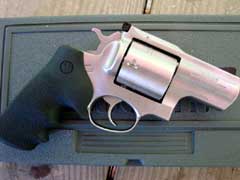
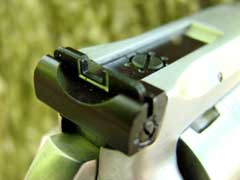
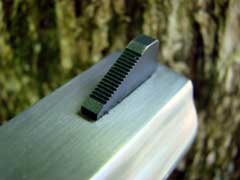
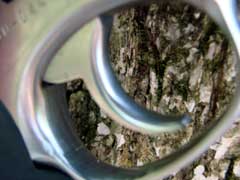
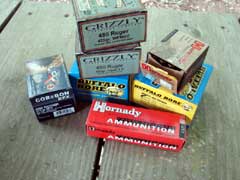
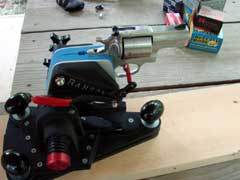


Author tested the Alaskan with a good variety of
ammo, using his Ransom Master machine rest.
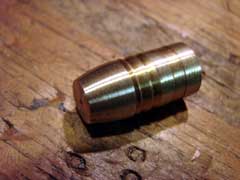
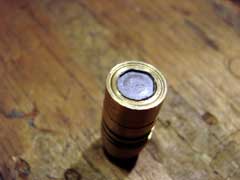
Jeff loves Belt Mountain's Punch Bullets. They are
supremely well-crafted, and tough enough to take any
game that walks the Earth.

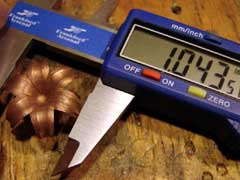
Another excellent bullet choice is Barnes' great
XPB bullet.
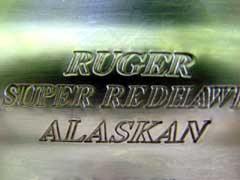
|
  
Got something to say about this article? Want to agree (or
disagree) with it? Click the following link to go to the GUNBlast Feedback Page.
|
Click pictures for a larger version.

Ruger's new five-shot .480 Alaskan revolver.
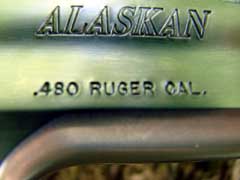
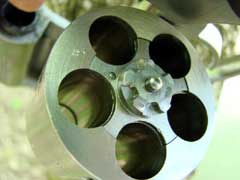
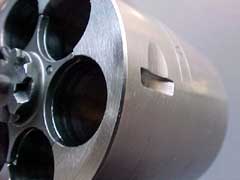
The new Alaskan's five-shot cylinder (top) compared to
the original six-shot version (bottom).
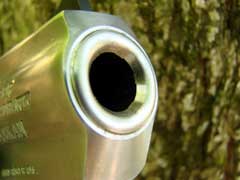

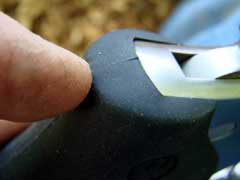
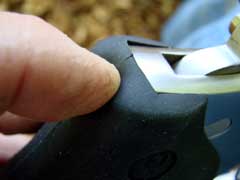
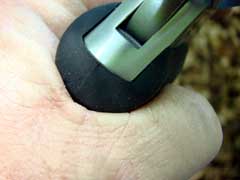

Soft rubber Hogue grips do a great job of softening the
recoil of the .480 Ruger cartridge.
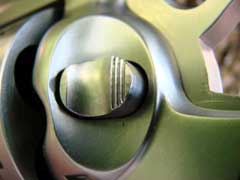
Cylinder release.

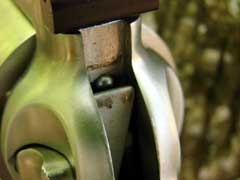
Like all Ruger revolvers, the Alaskan features Ruger's
Transfer Bar safety.
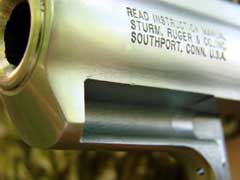
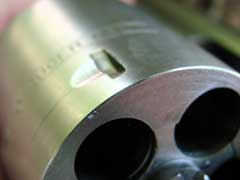
Cylinder bolt notches are offset for strength.
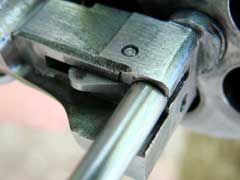
Crane locks into the frame, making for a solid lockup at
both front & rear of cylinder.

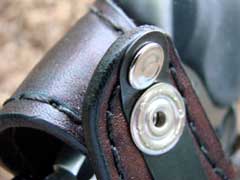
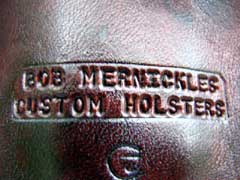
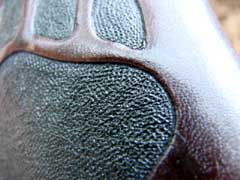
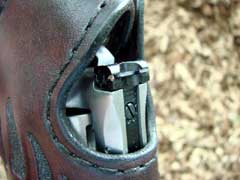
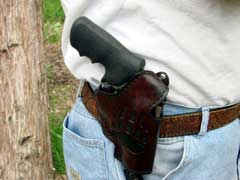
This beautiful holster by Bob Mernickle is just the
ticket for packin' the Alaskan!
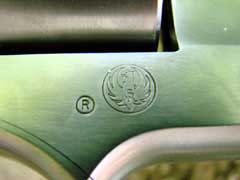
|
![]()